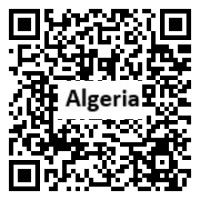Introduction
Background
Algeria was heavily colonized by the French in the late 19th and early 20th centuries. A bloody eight-year struggle culminated in Algerian independence in 1962.
Geography
Area
total: 2,381,740 sq km
land: 2,381,740 sq km
water: 0 sq km
Climate
arid to semiarid; mild, wet winters with hot, dry summers along coast; drier with cold winters and hot summers on high plateau; sirocco is a hot, dust/sand-laden wind especially common in summer
Natural resources
petroleum, natural gas, iron ore, phosphates, uranium, lead, zinc
People and Society
Population
44,758,398 (2023 est.)
Ethnic groups
Arab-Berber 99%, European less than 1%
Languages
Arabic (official), French (lingua franca), Berber or Tamazight (official); dialects include Kabyle Berber (Taqbaylit), Shawiya Berber (Tacawit), Mzab Berber, Tuareg Berber (Tamahaq)
Religions
Muslim (official; predominantly Sunni) 99%, other (includes Christian, Jewish, Ahmadi Muslim, Shia Muslim, Ibadi Muslim) <1% (2012 est.)
Population growth rate
1.62% (2023 est.)
Government
Government type
presidential republic
Capital
name: Algiers
Executive branch
chief of state: President Abdelmadjid TEBBOUNE (since 12 December 2019)
head of government: Prime Minister Nadir LARBAOUI (since 11 November 2023)
Legislative branch
description: bicameral Parliament or Barlaman consists of:
Council of the Nation or Majlis al-Umma (174 seats, statutory; 170 currently); two-thirds of members indirectly elected by simple majority vote by an electoral college composed of local assemblies within each wilaya, and one-third of members appointed by the president; members serve 6-year terms with one-half of the membership renewed every 3 years)
National People's Assembly or al-Majlis al-Sha'abi al-Watani (407 seats, including 8 seats for Algerian diaspora); members directly elected in multi-seat constituencies by open-list proportional representation vote using the Hare quota method; members serve 5-year terms)
Economy
Economic overview
suffering oil and gas economy; lack of sector and market diversification; political instability chilling domestic consumption; poor credit access and declines in business confidence; COVID-19 austerity policies; delayed promised socio-economic reforms
Real GDP (purchasing power parity)
$487.716 billion (2021 est.)
$471.223 billion (2020 est.)
$496.547 billion (2019 est.)
Real GDP per capita
$11,000 (2021 est.)
$10,800 (2020 est.)
$11,600 (2019 est.)
Agricultural products
potatoes, wheat, milk, watermelons, barley, onions, tomatoes, oranges, dates, vegetables
Industries
petroleum, natural gas, light industries, mining, electrical, petrochemical, food processing
Remittances
1.17% of GDP (2020 est.)
1.04% of GDP (2019 est.)
1.13% of GDP (2018 est.)
Exports
$41.776 billion (2021 est.)
$24.902 billion (2020 est.)
$38.551 billion (2019 est.)
Exports - partners
Italy 13%, France 13%, Spain 12%, United States 7%, United Kingdom 7%, India 5%, South Korea 5% (2019)
Exports - commodities
natural gas, crude petroleum, refined petroleum, fertilizers, ammonia (2021)
Imports
$44.322 billion (2021 est.)
$42.347 billion (2020 est.)
$54.259 billion (2019 est.)
Imports - partners
China 18%, France 14%, Italy 8%, Spain 8%, Germany 5%, Turkey 5% (2019)
Imports - commodities
refined petroleum, wheat, packaged medical supplies, milk, vehicle parts (2019)
Exchange rates
Algerian dinars (DZD) per US dollar -
Exchange rates:
135.064 (2021 est.)
126.777 (2020 est.)
119.354 (2019 est.)
116.594 (2018 est.)
110.973 (2017 est.)
Page last updated: Thursday, December 14, 2023
